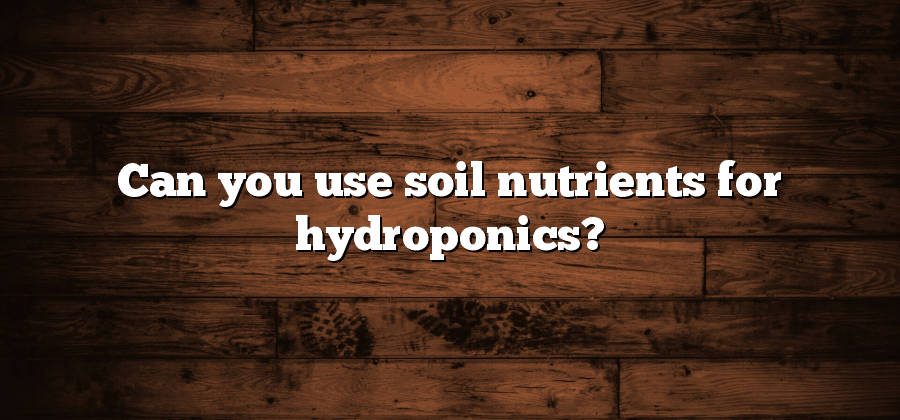What Are Soil Nutrients?
Soil nutrients are vital elements that are naturally present in the soil and are essential for the growth and development of plants. These nutrients, also known as essential nutrients, are required by plants in different quantities for various functions such as photosynthesis, protein synthesis, and overall metabolic processes. The three most important nutrients are nitrogen, phosphorus, and potassium, also known as NPK, which are commonly found in fertilizers.
Different types of soil may have varying levels of these essential nutrients, and the availability of nutrients in the soil can greatly affect plant growth. It is important for gardeners and farmers to understand the nutrient content of their soil to ensure the optimal growth and health of their plants. Regular soil testing and monitoring can help determine if any specific nutrients are lacking or excessive in the soil, allowing for proper adjustments to be made through the addition of fertilizers or other soil amendments.
Soil nutrients play a critical role in the overall fertility and productivity of the soil. They support plant growth and contribute to the development of robust root systems, healthy leaves, and abundant harvests. By ensuring a good balance of nutrients, gardeners and farmers can maximize their crop yields and improve the overall quality of their plants. Additionally, understanding the specific nutrient requirements of different plants can help tailor fertilization practices to meet their unique needs, leading to more effective and efficient nutrient uptake by the plants.
Benefits of Hydroponics
Hydroponics, the art of growing plants without soil, is gaining immense popularity in the agricultural world. One of the key benefits of hydroponics is its ability to optimize nutrient delivery to plants. Unlike traditional soil-based farming, where plants extract nutrients from the soil, hydroponics allows for precise control over the nutrients plants receive. This results in healthier, more vigorous growth, increased yields, and better quality produce.
Furthermore, hydroponics offers the advantage of water conservation. With this method, plants are grown in a recirculating system that uses significantly less water compared to traditional agriculture. The water used in hydroponics is recycled and reused, minimizing wastage. Additionally, the controlled environment of hydroponics reduces the risk of nutrient runoff and pollution, making it an environmentally friendly farming alternative.
Understanding the Hydroponic System
Hydroponics, a modern method of growing plants without soil, has gained popularity due to its numerous advantages. Understanding the hydroponic system involves grasping the fundamental components and processes that make it an efficient and sustainable method of cultivation.
At the core of the hydroponic system lies the growing medium. Unlike traditional soil-based methods, hydroponics utilizes inert materials such as coconut coir, perlite, or clay pebbles to provide support to the plants’ root systems. These mediums enable the plants to anchor themselves while providing ample access to water and nutrients. Additionally, the absence of soil eliminates issues related to pests, diseases, and weed growth, creating a stable and controlled environment for plant cultivation. The hydroponic system also involves the crucial element of nutrient solution. This solution consists of a carefully balanced mix of essential minerals and elements, such as nitrogen, potassium, and phosphorus, that are dissolved in water. By delivering the nutrient solution directly to the plant’s roots, hydroponics ensures maximum nutrient uptake and plant growth, resulting in higher yields and quality crops.
The Role of Nutrients in Hydroponics
Hydroponic systems offer an innovative and efficient way of growing plants without the need for traditional soil. Instead, plant roots are submerged in a nutrient-rich water solution that provides all the essential elements required for healthy growth. These nutrients play a crucial role in hydroponics, as they are the key to ensuring plants receive the necessary food to thrive and produce high yields.
In hydroponics, nutrients are carefully balanced and measured to create an optimal growing environment for plants. Essential macronutrients such as nitrogen, phosphorus, and potassium, as well as secondary and micronutrients, are carefully formulated in precise ratios. This precise control over nutrient levels allows hydroponic growers to customize the nutrient solution for different plant species and growth stages, ensuring that plants receive the perfect balance of nutrients they need for optimal growth and development. Additionally, the ability to control nutrient levels allows for instant adjustments if any deficiencies or imbalances are detected, providing a quick response to any issues and promoting overall plant health in the hydroponic system.
Differences Between Soil and Hydroponic Nutrients
Soil and hydroponic growing systems differ significantly in their nutrient requirements. When it comes to nutrients, soil relies on the natural composition of the earth, while hydroponics utilize a completely different approach. In soil-based systems, plants draw nutrients from the organic matter and minerals present in the soil. These nutrients undergo decomposition and mineralization processes, becoming available to plants over time. On the other hand, hydroponic systems provide plants with a precise and controlled blend of nutrients directly through a nutrient solution. This solution is formulated to provide the essential elements that plants need for growth and development.
One key difference between soil and hydroponic nutrients lies in their composition. In soil, nutrients are present in various forms, some of which are more readily available to plants than others. These forms include organic matter, minerals, and microbial activity. In hydroponics, nutrients are in a highly soluble and easily accessible form. This enables plants to take up nutrients more efficiently, resulting in faster growth rates and higher yields than in traditional soil-based systems. Additionally, because the nutrient solution in hydroponic systems is closely monitored and adjusted, it can be tailored to meet the specific needs of different plant species, ensuring optimal nutrition for each crop.
In conclusion, understanding the differences between soil and hydroponic nutrients is essential for successful plant cultivation. While soil-based systems rely on the natural composition of the earth for nutrient availability, hydroponics offer precise control over nutrient delivery through a carefully formulated solution. This distinction in nutrient source and composition contributes to the unique advantages and benefits that hydroponics bring to modern agriculture.






